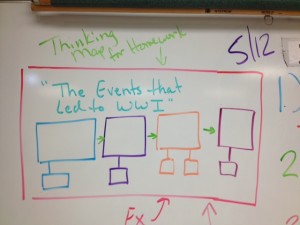Good morning everyone! As we wrap up Chapter 29 tomorrow we will see if all the work we did on WWI has really sunk in! Our quiz tomorrow on Chapter 29 Sections 1-4 will have 35 questions (14 matching and 21 multiple choice questions) . You have all of your vocab and all the notes so make sure you study hard!!!
Here’s what we did today:
Tuesday-5/20/13:
o Bell Work-1. What was the goal of Woodrow Wilson’s Fourteen Points? 2. What was the “war guilt” clause in the Treaty of Versailles? 3. Why did the U.S. reject the Treaty of Versailles?
o Attendance- While Class is Doing Bell Work
o Quick Vocabulary Match-up Review Activity-Chapter 29-The Great War-Part 2
o Student Led Notes-Chapter 29-Section 4-A Flawed Peace
o Daily Objective-
o Content Objective:
SWD analysis of key terms associated with our unit covering Chapter 29 Sections 1 through 4 through the manipulating of vocabulary terms in a collaborative activity
SWD creation of the principals of self-determination and Wilson’s Fourteen Points along with effects of the War Guilt Clause on Germany through compiling information in student led guided notes.
o Language Objective:
Students will read and orally match up important vocabulary terms pertaining to our unit covering Chapter 29 Sections 1 through 4 by using a vocabulary match-up activity
Students will read and record and orally share information on the principals of self-determination and Wilson’s Fourteen Points along with effects of the War Guilt Clause on Germany by creating student centered guided notes
Supplemental Material: Chapter 29 Vocab Match-up Terms Part 1, Chapter 29 Vocab Match-up Terms Part 2, Chapter 29-Section 4-Guided Notes and The Great War-PPT
Chapter 29 Vocab Match-up Terms Part 1
Chapter 29-Part 1-Vocab Match up Terms
Chapter 29 Vocab Match-up Terms Part 2
Chapter 29-Part 2-Vocab Match up Terms
Chapter 29-Section 4-Guided Notes
Chapter 29-Section 4-Guided Notes
The Great War-PPT
